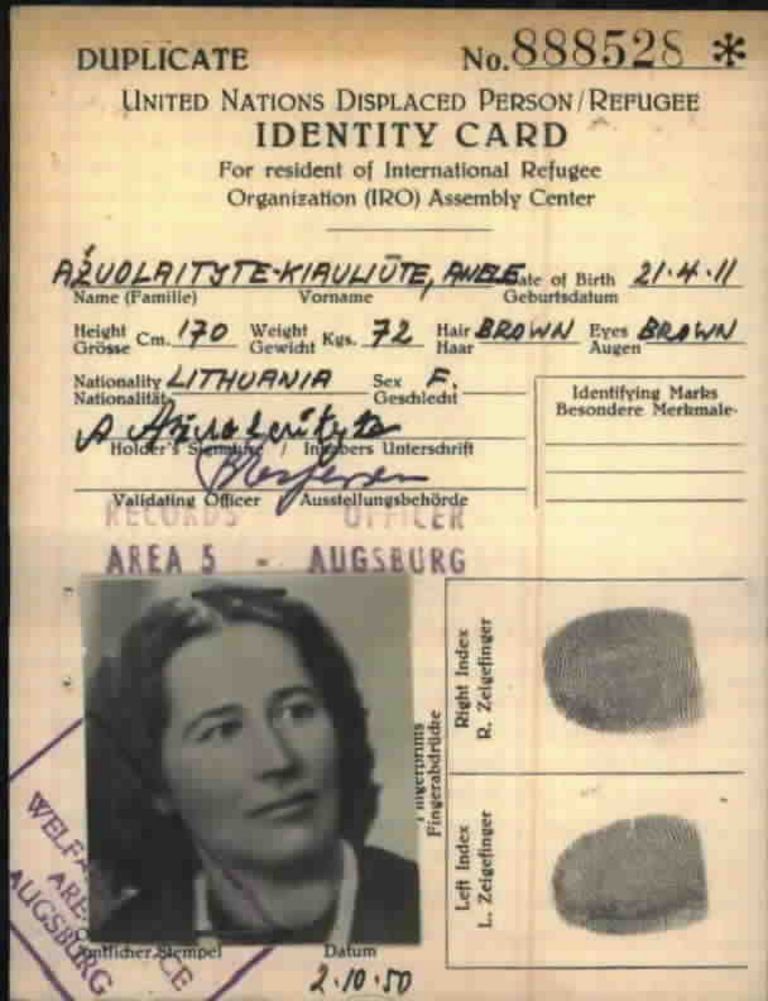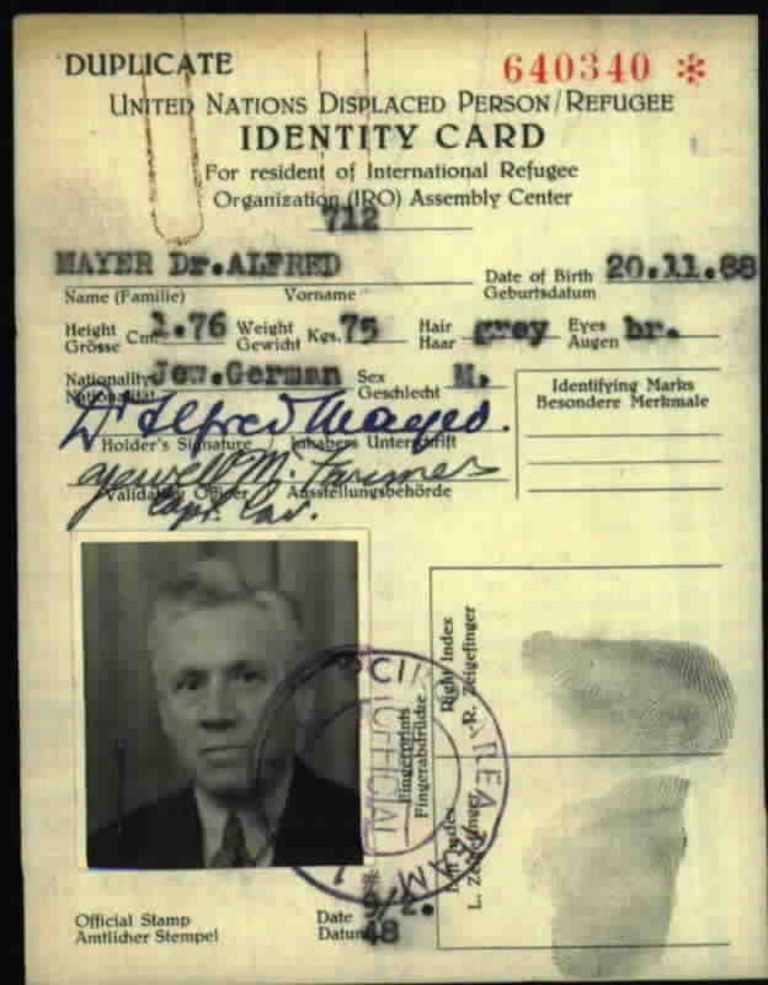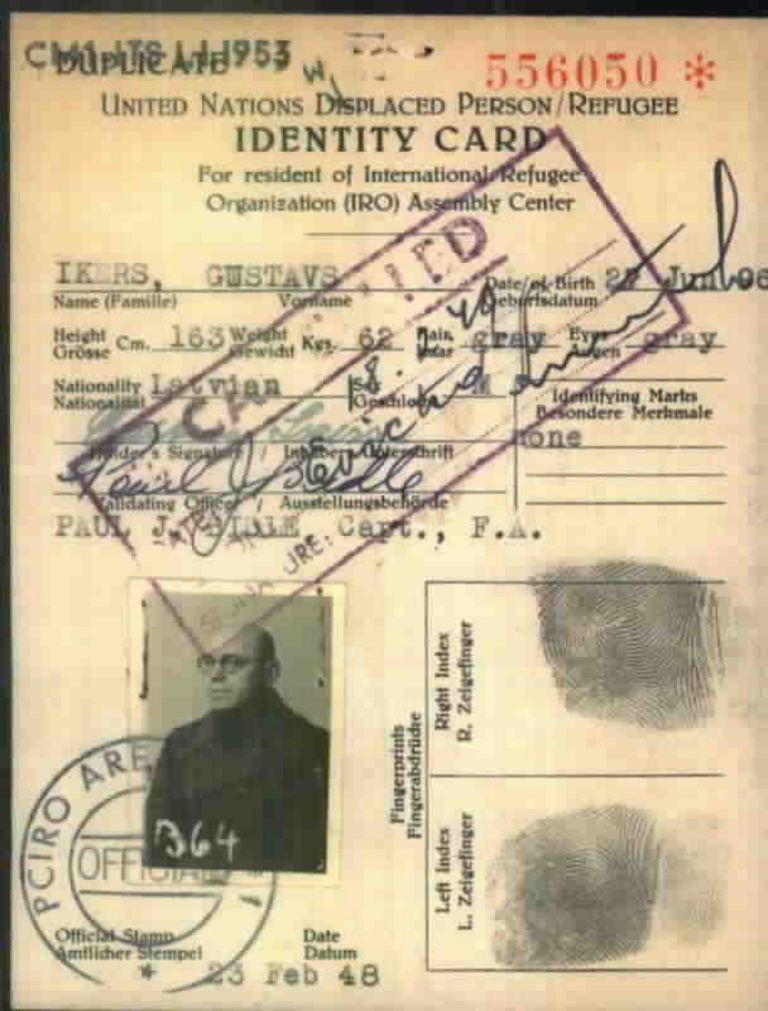Page of
Page/
- Reference
- Intro


From January 1948 onward, the DP identity card in the US zone fulfilled an important task: with a passport photo, fingerprints and signature, it proved that the person who held it was eligible to live in a DP camp. DPs used the card to identify themselves, and IRO employees in the camps could see at a glance that they were responsible for providing care to the respective person.
Since there were precise instructions for issuing DP identity cards, the cards all look very similar. The biggest difference is that the DPs carried the original card with them, while the duplicate remained in the camp administration. The originals, some of which have been preserved in the Arolsen Archives, are therefore often torn and folded.
From January 1948 onward, the DP identity card in the US zone fulfilled an important task: with a passport photo, fingerprints and signature, it proved that the person who held it was eligible to live in a DP camp. DPs used the card to identify themselves, and IRO employees in the camps could see at a glance that they were responsible for providing care to the respective person.
Since there were precise instructions for issuing DP identity cards, the cards all look very similar. The biggest difference is that the DPs carried the original card with them, while the duplicate remained in the camp administration. The originals, some of which have been preserved in the Arolsen Archives, are therefore often torn and folded.
Questions and answers
-
Where was the document used and who created it?
The US military administration knew that some of the people living in the DP camps did not meet their criteria for DP status. To ensure that only eligible DPs were admitted to the camps, the military administration ordered new identity cards to be issued in 1948. Teams of military representatives visited the camps together with IRO employees and checked the inhabitants’ documents. If a person was within the mandate of the IRO, the officials filled out two pre-printed identity cards. The original card was given to the DPs, who always carried it with them, while the duplicate, which contained the same information, remained in the camp administration for control purposes. IRO employees in the Control Centers later took on the task of issuing the identity cards.
- When was the document used?
On January 7, 1948, the US military administration ordered that DPs should receive identity cards, and officials immediately began issuing the cards in the camps. From this date until the end of 1951, anyone who arrived as an eligible DP in a camp was given an identity card. The identity cards were valid until January 1, 1952, the date on which the IRO ended its operations.
- What was the document used for?
In the postwar period, many thousands of people gathered in the DP camps. Particularly in the large camps, it was often not clear whether all of the inhabitants were eligible DPs. People could be expelled from a camp if they had not met the deadline for arriving in the US zone or if they were subject to a regulation stating that they could only receive legal support. In order for officials to be able to verify who was an eligible DP in the camp, the DPs were issued special identity cards. The employees in the camps could then see at a glance whether the person had the right to receive support. Anyone without a DP identity card had to leave the camp.
Identity cards were issued in all DP camps in the US zone following the same procedure. Teams of IRO employees and military representatives visited the camps and filled out two pre-printed cards for each positively identified DP (including newborns), either on a typewriter or by hand in ink. The camp inhabitants were told in advance to bring two passport photos that would be pasted to the DP identity card. The military officer in charge would then compare the new identity card with earlier identity cards and the DP 2 card, which was held by the camp administration. The original identity card was given to the DP, while the duplicate remained in the respective camp. The old UNRRA identity cards were declared invalid and destroyed as soon as all camp inhabitants had the new IRO identity card.
After all the DPs living in camps at the start of 1948 had been given identity cards, the procedure changed. If the review of a DP’s CM/1 application revealed that the person was supposed to receive what was known as “camp care,” an identity card was requested. The IRO informed the DPs that they could pick up their new identity card a few days later from the camp administration or Control Center. The DPs had to confirm that they had received the identity card.
The identity card lost its validity if a DP left the camp to emigrate, for example. Loss of DP status could also invalidate the card; DPs who refused to emigrate (in the view of the IRO) and DPs who wanted to stay in Germany became what were known as “German Economy cases” and were thus the responsibility of the German government. Their DP identity cards were then withdrawn.
The importance of the identity card can be seen in the fact that DPs had to report the loss of their identity card to the police in the DP camp. Multiple letters from camp leaders, the IRO and other aid organizations also repeatedly refer to the DP identity card. IRO employees noted the identity card number on many other documents as well, such as the DP 2 card and Certificate of IRO Eligibility. The DPs also needed their identity card in many other situations to verify who they were. For example, when DPs had to attend appointments while they were preparing to emigrate, they used the cards to identify themselves. In the camps, the duplicates of the identity cards were collected and updated for control purposes.
- How common is the document?
Theoretically, there must have been two identity cards for each DP who lived in a camp in the US zone from January 1948 onward. Since the originals were kept by the DPs, the Arolsen Archives now hold more duplicates than originals. However, it is not possible to say exactly how many DP identity cards issued by the IRO have been preserved in the Arolsen Archives. This is because ITS employees sorted the cards following an alphabetical-phonetic system and filed them together with other documents in the postwar card file (Nachkriegszeitkartei, Collection 3.1.1.1). This made it easier to search for references to people, but it also means there is no indication of how common the DP identity cards are. However, in the near future, modern computer technology will find the answer: clustering techniques will make it possible to identify and thus count the DP identity cards and other types of documents.
- What should be considered when working with the document?
Various DP identity cards were issued at different times in the individual occupation zones. The IRO identity card was the successor to the D.P. identification card previously issued by UNRRA. Both cards were only used in the US zone. In the French zone, the military administration issued a Carte d’identité de Personnes Déplacées, while PWX/DP Registration/Identity Card were used in the British zone. Although the cards were issued by different offices, they all served the same purpose: to identify DPs as DPs.
The DP identity card issued by the IRO in the US zone was initially only supposed to be given to DPs who were housed in a camp. So-called free-living DPs who resided outside of camps in private accommodations did not receive them at first. Instead, they were supposed to identify themselves with the Certificate of Eligibility. This rule was apparently expanded later on – possibly from May 1950 – because identity cards even exist for DPs who did not receive support in a camp. If you have any information about this later regulation, please send your feedback to eguide@arolsen-archives.org.
Help for documents
About the scan of this document <br> Markings on scan <br> Questions and answers about the document <br> More sample cards <br> Variants of the document





